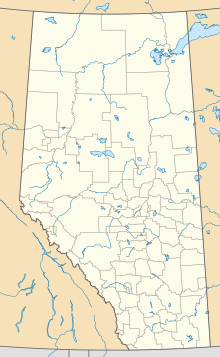Norglenwold
Norglenwold | |
|---|---|
| Summer Village of Norglenwold | |
Location of Norglenwold in Alberta | |
| Coordinates: 52°19′26″N 114°07′26″W / 52.324°N 114.124°W | |
| Country | Canada |
| Province | Alberta |
| Census division | No. 8 |
| Government | |
| • Type | Municipal incorporation |
| • Mayor | Jeff Ludwig |
| • Governing body | Norglenwold Summer Village Council |
| Area (2021)[2] | |
| • Land | 0.62 km2 (0.24 sq mi) |
| Population (2021)[2] | |
| • Total | 306 |
| • Density | 490.8/km2 (1,271/sq mi) |
| Time zone | UTC−7 (MST) |
| • Summer (DST) | UTC−6 (MDT) |
| Website | Official website |
Norglenwold is a summer village in central Alberta, Canada. It is located on the southeast shore of Sylvan Lake adjacent to the Town of Sylvan Lake.
Demographics
[edit]In the 2021 Census of Population conducted by Statistics Canada, the Summer Village of Norglenwold had a population of 306 living in 132 of its 204 total private dwellings, a change of 12.1% from its 2016 population of 273. With a land area of 0.62 km2 (0.24 sq mi), it had a population density of 493.5/km2 (1,278.3/sq mi) in 2021.[2]
In the 2016 Census of Population conducted by Statistics Canada, the Summer Village of Norglenwold had a population of 273 living in 112 of its 211 total private dwellings, a 17.7% change from its 2011 population of 232. With a land area of 0.62 km2 (0.24 sq mi), it had a population density of 440.3/km2 (1,140.4/sq mi) in 2016.[3]
See also
[edit]- List of communities in Alberta
- List of summer villages in Alberta
- List of resort villages in Saskatchewan
References
[edit]- ^ "Municipal Officials Search". Alberta Municipal Affairs. May 9, 2019. Retrieved October 1, 2021.
- ^ a b c "Population and dwelling counts: Canada, provinces and territories, and census subdivisions (municipalities)". Statistics Canada. February 9, 2022. Retrieved February 9, 2022.
- ^ "Population and dwelling counts, for Canada, provinces and territories, and census subdivisions (municipalities), 2016 and 2011 censuses – 100% data (Alberta)". Statistics Canada. February 8, 2017. Retrieved February 8, 2017.
External links
[edit]

